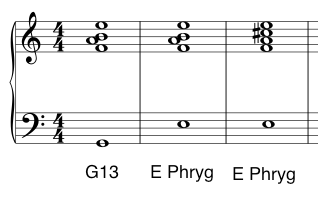Introduction
Phrygian Chords are simply sus♭9 chords. They are derived from either the:
- Phrygian mode (3rd mode of Major Scale); or
- Dorian ♭2 mode (2nd mode of the melodic minor scale).
And you can use these two modes to improvise over Phrygian Chords.
Unavailable Tensions (AKA Avoid Notes)
Let’s look at the E Phrygian mode (3rd mode of C Major). If we take E Phrygian mode and derive the tonic 7th chord and tonic 13th chord of that key we get:
- E Phrygian Scale = E F G A B C D
- Associated 7th Chord = Em7 = E G B D
- Associated Extended Chord = Em7♭9♭13 = E G B D F A C
Notice that the extended 13th chord derived from the E Phrygian mode is Em7♭9♭13. Now, as we learned in the lesson on Available Tensions, neither the ♭9 nor the ♭13 are available tensions over a m7 chord. The Phrygian Chord exists to fix this problem.
And as we learned in the previous lesson, in Jazz, suspended chords act as substitutions for V7 chords. The Phrygian Chord is no different.
Phrygian Chords
So let’s look at the Em7♭9♭13 chord again. By changing the ♭3rd into a 4th, we turn the Em7♭9♭13 into a E7sus♭9♭13. And if we drop the 13th, then we have an E7sus♭9 (or Esus♭9) – the E Phrygian Chord. By doing this, we have turned a Em7 chord into an E7 (substitute) chord. The benefit of this is that the ♭9 and ♭13 ARE BOTH available tensions over a V7 chord.
- E7sus♭9 = E A B D F
The E Phrygian Chord can also be derived from the 2nd mode of D melodic minor (E Dorian ♭2 Mode) for the same reason.
| Mode | Key | Notes | Voicing | Avoid Note |
|---|---|---|---|---|
| E Phrygian | 3rd mode of C Major | E F G A B C D E | LH: E RH: F A B E | C |
| E Dorian b2 | 2nd mode of D melodic minor | E F G A B C# D E | LH: E RH: F A C# E | None |

The only difference between the two scales is that the E Dorian ♭2 has a C# while the E Phrygian has a C♮. To differentiate between the Phrygian Chord derived from the Phrygian mode and the Dorian ♭2 mode, the latter is generally voiced with a C# (as seen above).
Notice also that the E Phrygian Chord is very similar to a Rootless G13 chord – only with an E in the bass. As such, another way of notating Phrygian Chords is G7/E
The Phrygian Chord acts as a substitute for:
- V7 Chords;
- Regular Sus Chords (which themselves are substitutes for V7 chords);
- II-V progressions.
The E Phrygian Chord, being a substitute for an E7, wants to resolve to an AMaj7 chord (down a 5th). Keep in mind that just because a chord is derived FROM a particular key, does NOT mean you cannot use it IN a different key. So just because the E7sus♭9 is derived FROM the key of C Major (or D melodic minor), does NOT mean you cannot use it over a chord progression IN the key of A Major. We will return to this idea in detail in the next module on Jazz Scales.
So now let’s do exactly that. Let’s use the E Phrygian Chord to substitute the II and/or V chords of a II-V-I in A Major:
| ii | V | I |
|---|---|---|
| Bm7 | E7 | AMaj7 |
| Bm7 | Esus♭9 | AMaj7 |
| Esus♭9 | E7 | AMaj7 |
| Esus♭9 | Esus♭9 | AMaj7 |
Improvisation
The Phrygian mode is a minor scale (it has a ♭3) and as such you would expect to use it over a minor chord. However, it also has a ♭2 which is one semitone above the root note and therefore an avoid note. As a result, this scale is quite dissonant when played over a m7 chord and thus is generally not used over m7 chords other than the iii chord (the chord from which the mode is derived).
As such, we only use the Phrygian mode to improvise over a:
- Phrygian Chord; or
- iii chord.
For example, if we take the chord progression: | Em7 | D7 | GMaj7 ||
This chord progression is in the key of G Major and the Em7 chord is a vi chord. Therefore we should NOT use the E Phrygian mode to improvise over the Em7.
But, if we take the chord progression: | Em7 | Dm7 | CMaj7 ||
This chord progression is in the key of C Major and the Em7 chord is a iii chord. Therefore we CAN use the E Phrygian mode to improvise over the Em7.
And, if we take the chord progression: | Bm7 | E7sus♭9 | AMaj7 ||
This chord progression is in the key of A Major and the second chord is a Phrygian chord.
Therefore we CAN use the E Phrygian mode to improvise over the E7sus♭9.
If the above doesn’t make sense, don’t worry. We are skipping ahead a bit. We will cover this topic in great detail in the next two modules.
In Practice
You may occasionally (though not often) see Phrygian Chords written out in lead sheets as either:
- E Phryg
- E7sus♭9
- G7/E
However, you can also use them like a regular chord substitution over a V7 chord.
Have a Listen to
- Dolphin Dance ~ Herbie Hancock
- Flamenco Sketches ~ Miles Davis
- Spain ~ Chick Corea